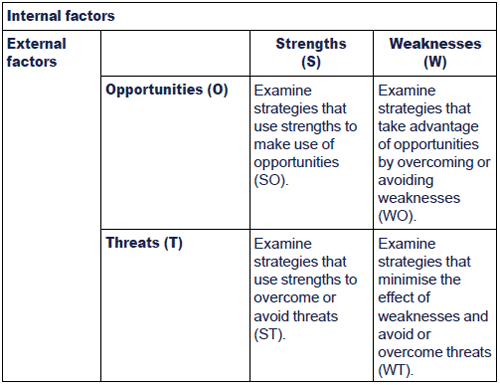SWOT analysis
A SWOT analysis is a popular tool to use as part of the strategic analysis step within the overall strategic planning process:

SWOT
SWOT analysis examines the Strengths, Weaknesses, Opportunities and Threats of an organisation.
This is an integral part of strategic analysis. Unlike a PEST analysis, say, which focuses on external environmental issues, SWOT analysis used to view the internal and external situation that an organisation finds itself in.
Strengths and weaknesses examine what an organisation internally does well or badly, while opportunities and threats look at positive and negative factors that might impact on the organisation externally.
A SWOT analysis can be used as an analysis tool in its own right or can be used as a summary sheet on which other results can be placed.
- Strengths and weaknesses relate to resources and capabilities: what is the organisation good at? What is it poor at? Where are resources in short supply? Where are resources excellent?
- Opportunities and threats relate to external factors: what will the effect on the organisation be of economic changes? Can the organisation make use of new technologies? Are new entrants likely to enter the market place? Can a powerful customer dictate terms?
Using the SWOT to generate strategy options
Strategic direction should 'fit' the results of the SWOT analysis.
Used in this way a SWOT analysis is sometimes referred to as a TOWS matrix.

Illustration
(1)A company has a prestigious brand name and is wondering whether or not to enter a new emerging foreign market.
Suggestion: (SO) the prestigious brand name is a strength and the emerging market is an opportunity. The company could make use of the brand name by adopting a differentiation or focused differentiation strategy.
(2)A company has a poor distribution network, but wants to start exporting to lucrative overseas markets.
Suggestion: (WO) Collaboration with a company that has a good distribution network might overcome the weakness so as to make use of the opportunity.
(3)A company is facing new competition from cheap overseas manufacturers. The company has a long-standing reputation for good quality products.
Suggestions: (ST) The company could move towards a differentiation strategy to try to make use of its reputation for quality to counter the competitive threat. This might not work if the imports were also of good quality and cheaper. Perhaps relocating manufacturing abroad would give a low cost-base but retain the strength of the company's reputation.
(4)A company has old product lines and is facing dynamic competition from new producers.
Suggestion: (WT) The most difficult scenario to deal with as nothing is going right - weaknesses and threats combined. Repositioning itself might help so that the company was seen as a seller of more traditional goods. Spending on new design and products would help to eradicate the weakness.
|
Created at 10/12/2012 10:11 AM by System Account
(GMT) Greenwich Mean Time : Dublin, Edinburgh, Lisbon, London
|
Last modified at 2/27/2014 9:54 AM by System Account
(GMT) Greenwich Mean Time : Dublin, Edinburgh, Lisbon, London
|
|
|
|
 |
Rating
:
|
 Ratings & Comments
(Click the stars to rate the page) Ratings & Comments
(Click the stars to rate the page)
|
 |
Tags:
|
|
|
|
|